After I wrote the last piece about resonant orbits I thought I would write a bit about orbits in general and what they are. The fact is that for a long time, a few thousand years at least, we have known that some of the things we can see in the sky go round some of the other things. If you thinks this sounds a bit vague then you are absolutely right, it is very vague because that was about all we knew. For a long time we thought that everything revolved around the Earth which is logical enough, it certainly looks like that from where we are. The problem with this model was that it required more and more complicated tweaking to make it match our observations and measurements which were getting more and more accurate. Eventually it could no longer be denied that everything in the Solar System went around the Sun, well all the big stuff, smaller things revolved around the bigger things but this meant that they too went around the Sun, just indirectly.
Once we worked that out it explained everything we observed about the motions of the planets in the sky. It was also assumed for a long time that these orbits were circular, for the simple reason that the circle was thought of as a perfect shape, again understandable really, until we achieved a better understanding of celestial mechanics. This animationshows a somewhat exhagerated ellipse which is also known as an eccentric orbit-
So this is an ellipse and how it works. Let’s start with Newton, Sir Isaac Newton who, amongst other things worked out that there is something called gravity keeping everything together. He knew what it did but not what it was, how it acually worked. A lot later along comes Einstein and says that everything with mass makes a dent in the fabric of space-time and that if someting comes along and gets too close to that dent then it falls towards the object making this dent, but if it is moving at an angle to the object it will “fall” past it and continue to do so, round and round.
The details behind the elliptical orbit were worked out by Johanas Kepler who came up with three laws describing elliptical orbits.
This is what it is all about. Kepler’s First Law states that when an object orbits another it does so in an ellipse. The difference between an ellipse and a circle is that a circle has a point in the middle whereas an ellipse has two so called foci and the main object sits at one of these foci.
This means that the object in orbit will sometimes be closer and sometimes further away from the object it is orbiting. His second law says that if you draw a line between the two bodies then over a period of time this line will create a triangle. The interesting thing about this triangle is that if you measure a series of these triangles, they will all have the same area. This is because when the orbiting object, let’s call it a planet from now on, is closer to its star it is moving faster, which kind of makes sense as it is closer to the star’s gravity so the triangle is wider but shorter, and when it is furthest away it is moving slower so its triangle is thinner and longer.
So far so good, so now on to Kepler’s third law and this relates the average distance between the objects, the time taken for one orbit and the mass of the objects, and now things get really interesting for astronomers. You see quite often we want to know the mass of something, a star or a planet perhaps, but we can’t just weigh them, at least not directly. Kepler’s third law allows us to do this. If we can see that something is orbiting a star or a planet, we can measure the distance between them and how long it takes to go around the central object. This means that we can use Kepler’s third law to work out the mass. This means using maths so I apologise in advance but I will try to keep it as simple and painless as possible so take a deep breath, hold on tight to something and here we go!
Still there? M is the mass of the star, or planet, that something is orbiting, r is the radius or the distance between the objects, G is the “gravitational Constant”, which is just a number that makes a sum work, and T is the time it takes for one orbit. So from this we can find out the mass of the star and from the mass we can find out other stuff like, for example, its luminosity so just by knowing about orbits and the details of particular orbits, we can discover a lot about stars and planets.
One thing that we must remember about elliptical orbits is that they are not, as most descriptions and diagrams tell us, a case of one object going around another. In real life the objects orbit a common centre of gravity. In most cases, like planets orbiting stars and moons orbiting planets, this common central point is well within the body of the main object, but there are cases where this is quite different. Many binary stars have a centre of gravity which is actually in between the stars. In fact there is also such a case in our own back yard. Pluto and its moon Charon are similar enough in mass that they are mutually orbiting a point outside the body of Pluto. It looks like this-
As you can see, it looks like Pluto is orbiting an empty spot in space. What it, and Charon, are actually orbiting is the balancing point between the two.
This fact allows us to do something quite amazing. As a planet orbits a star, it pulls slightly on the star, making it wobble ever so slightly. With modern telescopes we can see and measure this wobble which allows us to discover planets orbiting other stars.
As I said before, orbits are elliptical but they are mostly very nearly circular. There is a neat way of showing the differnet types of ellipses called conic sections. What this means is taking a cone and cutting through it at different angles. If this is done horizontally we get a circle, which is basically just a special type of ellipse. If we cut it at other angles we get an ellipse as we usually think of it, a perabolla or a hyperbolla. A parabolla is an ellipse where the ends never meet, they become parallel and a hyperbolla is an ellipse which is open at the ends. This is what they look like-
As I wrote about last time, orbits can be in resonance with each other and this can have profound effects not only on the objects in a resonant orbit, but on everything else around them. Apart from the big stuff like rearranging giant planets, resonant orbits clear out all the stuff in particular orbits so that no planets can form there. There are bands in the Asteroid Belt where there are no larger asteroids at all for this reason and gaps in the rings of Saturn because of the gravitational effect of Saturn’s moons.
Another oddity that can occur with the complex interplay of orbits is the case of Cruithne, sometimes called Earth’s second moon. Cruithne is not another moon of Earth but an asteroid about 5 kilometers across which orbits the Sun in about an Earth year at an angle of almost 20 degrees in an orbit alomost the same as Earth. It is always a little bit above or below the Ecliptic, the plane of the Solar System and ahead of Earth so we are not going to crash into each other. Because of this, Cruithne is always close to Earth but not actually in orbit around Earth. Cruithne’s orbit looks like this seen from above,
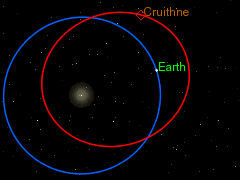 but as seen from Earth it looks like it has a peanut shaped orbit!
but as seen from Earth it looks like it has a peanut shaped orbit!
So orbits are quite complicated and they can give some surprising results . Their very existence has taught us a lot about our place in the Universe and the details of an orbit can teach us other, seemingly unrelated things about a star or a planet just by watching something go around it and they can allow us to discover worlds orbiting other stars so orbits are, in their own way, magical.
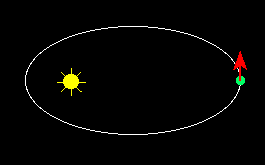

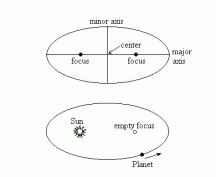
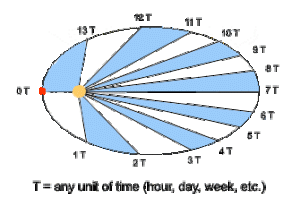

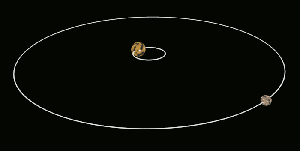
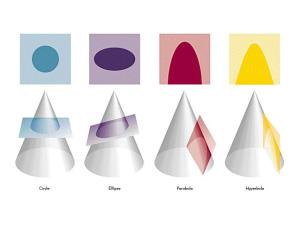
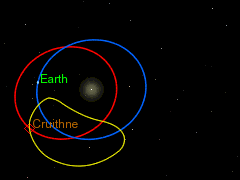
Reblogged this on petercooper1960's Blog.
LikeLike